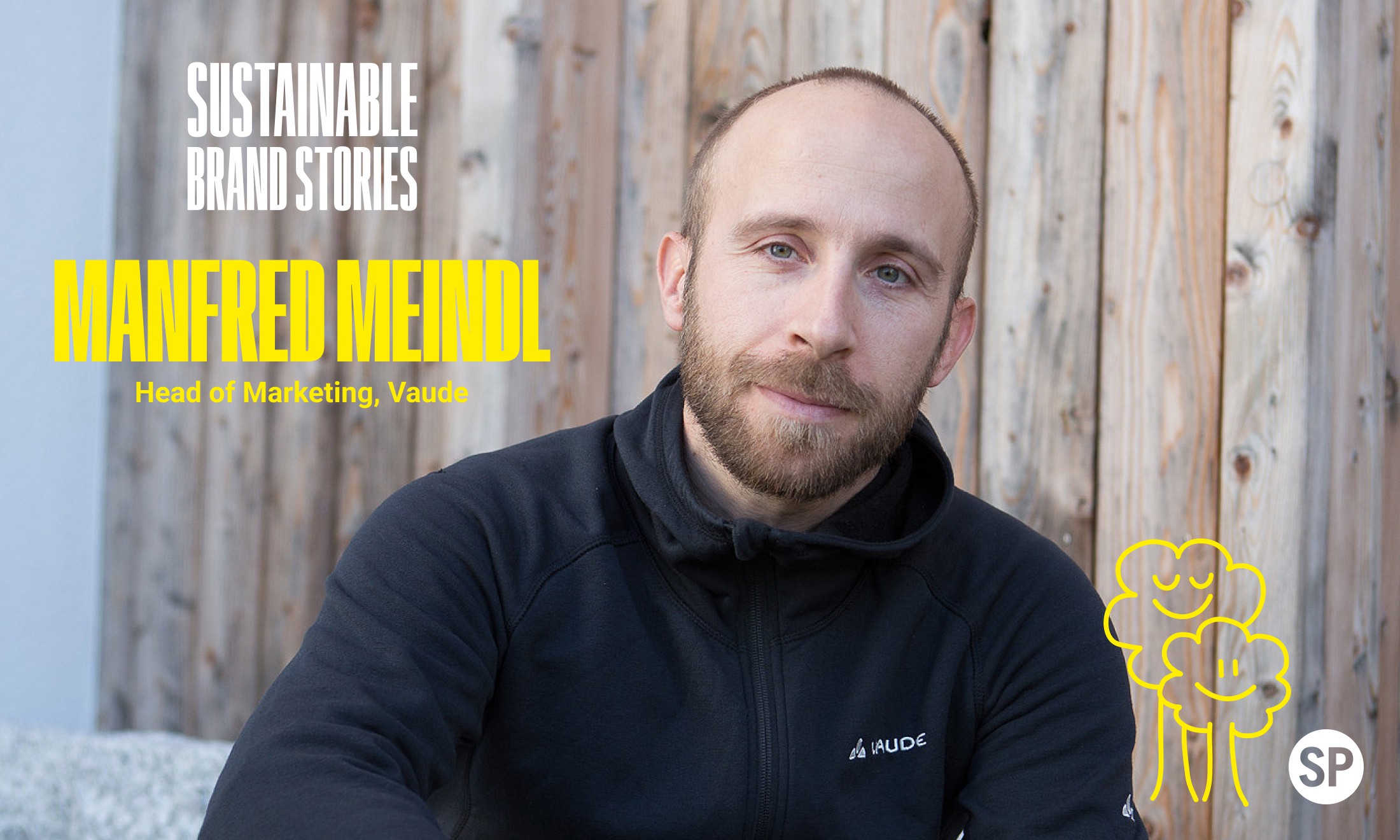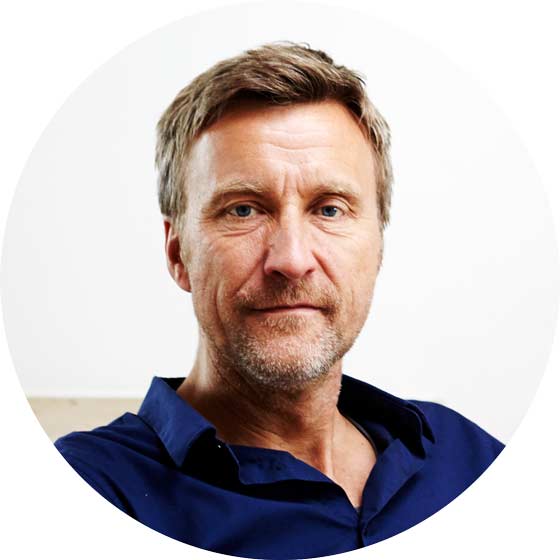Strichpunkt Sustainability Talk #7
Manfred Meindl

After a years-long transformation process, Vaude is now considered Germany's more sustainable outdoor brand. We interviewed Manfred Meindl, Head of Marketing, about the costs of a sustainability makeover, frugal customers and media circuses as on-the-job training for its employees.
"We achieve above-average growth on a saturated market. And we suspect that this is due mainly to our steadfast sustainable brand image."
Vaude has done something many brands are still dreaming of: Not only does it practice sustainable business, it is also renowned for doing so. How does a brand get there?
By demonstrating authentic sustainability, making continuous progress and talking about its transformation process. On a journey like ours, a marketing manager learns a lot about what works for sustainability communications and what doesn't.
For example?
Among other things, we learned that we had to make sustainability – which is a complex, long-term and sometimes arduous topic – tangible for consumers. When we began our transformation process 12 years ago, we had somewhat theoretical discussions about our ultimate sustainability goals. But this got through only to a very advanced and well-informed target audience. The general public missed most of it. Today, we speak in very plain terms about the benefits that an activity or a new material has for individual customers.
That’s exactly what stumps a lot of brand managers.
We recently launched a jacket made from bio-based nylon on the market. While in the past we would have provided vague information about this cool alternative to castor oil, we now spotlight its environmental footprint and its specific, added performance features. This is the only way to reach mass markets and motivate more practical consumers to look for sustainability when making a purchase.
Can you be specific? How many more jackets does Vaude sell thanks to the brand’s reputation for sustainability?
All of the outdoor brands produce very similar products that must be functional. Of course they differ in terms of materials, manufacture and design as well as functional details, but ultimately they are similar. So when making a purchasing decision, what a brand expresses or what it stands for and what added value it offers is all the more important. A little logo has a big impact here. By the way, it's the same for retailers. Many of them use the Vaude brand to stock their sustainability sections and boost their own brand by association.
Vaude is Europe's number one sustainability brand, with Patagonia being the leader worldwide. Is the segment saturated now? Or is there still room for more among the relevant customers?
Our industry doesn't stand a chance unless we all become more sustainable. Everyone uses the same factories in Asia to make their products, after all. In global terms, Vaude’s production volume is fairly low, which means it can't exert as much influence. Together with other brands, we would have much higher production volume and thus a much better chance of getting production sites in Taiwan or elsewhere to switch from brown coal to solar power, for instance. We can't do it on our own.
Brand impact is a different story. There are only a few brands that can communicate their sustainability in a credible manner. To be on the same playing field as VAUDE, Patagonia and FjällRäven, other brands would have to really up their marketing game.
How much more are customers willing to spend on sustainable products?
To be honest, not much. Sustainability is just considered a given these days. Customers expect companies to improve their sustainability performance, but most of them hate to pay a premium for that – even if market research often tells a different story.
In other words, sustainability cuts into the margin.
Correct. Recycled polyester is much more expensive than brand-new, for example. If you consistently use more sustainable solutions for the entire supply chain, the costs are staggering. In order to maintain our margins in spite of this, we have been reducing our marketing budget for years. We let our products and processes speak for themselves.
What does your sustainable business model cost? And what are the benefits?
We have doubled our turnover since 2010. Even though we are a self-financed family company, we are seeing above-average growth on a saturated market. We suspect that this is due mainly to our steadfast sustainable image. Of course, there’s no way to prove that.
But Vaude also has a charismatic CEO who greatly supports sustainability and communicates the topic publicly.
But Antje von Dewitz wasn't always this figurehead. She grew into this role and greatly boosted the authenticity of our message. But these days our public image is communicated by more than one person. This is just one reason why I will talk about our approach during the Strichpunkt Online Session.
We now have not only Antje von Dewitz, but a number of other ambassadors. Ultimately, they include every one of our customer service employees because they are the first point of contact for many customers. We also founded a Vaude Academy for sustainable business, where our experts can share our sustainability skills with the public and deliver them to other companies and organisations.
But your sustainability communications don't end with products and processes. Vaude also takes a stance on such issues as the refugee crisis and climate change.
Companies are part of society, which means we have opinions on social issues that we will not hide. Communicating our opinions is now an essential part of our communications strategy. After Donald Trump was elected President of the United States and all the negative messages that began to shape the discourse in 2016, it was important for us to set a good example and show that we can tackle challenges together and make a difference. We wanted to show that we can be fair, environmentally friendly and financially successful at the same time. This basic message also works very well in B2B communications.
What do you mean by “successful”? How does your company measure success?
Ten years ago, people asked Antje von Dewitz about the company succession, or her dual role as mother and CEO. Today, “Spiegel”, “NZZ” and “The New York Times” interview her about the refugee crisis and social justice, which in media terms puts her at DAX company level. Not bad for a family business from Lake Constance!
On the downside, your clear stance makes your company vulnerable. And causes you to lose customers.
I would say that by communicating our opinions, we really get to know our customers. Communication hones our brand. I'm sure we have lost a few customers. During the refugee crisis, people called for boycotts of Vaude because we supported efforts to permit refugees that live and work in our society to stay in the country. These media circuses are no big deal for our PR team at this point. I think it's the perfect type of on-the-job training in resiliency. And, as I said, apart from a weather-related slump in 2018, our turnover has risen continually for the last ten years. Brands shouldn't be afraid to hold strong opinions.
Let's talk
Lust, über die nachhaltigen Potenziale Ihrer Marke zu sprechen?
Harald freut sich auf einen lockeren Austausch. Einfach eine kurze Nachricht an h.willenbrock@sp.design schreiben.

Harald Willenbrock
Head of Concept & Content